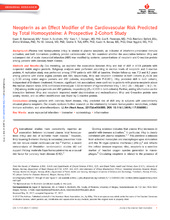| dc.contributor.author | Bjørnestad, Espen Øglænd | en_US |
| dc.contributor.author | Borsholm, Robert Andre | en_US |
| dc.contributor.author | Svingen, Gard Frodahl Tveitevåg | en_US |
| dc.contributor.author | Pedersen, Eva Ringdal | en_US |
| dc.contributor.author | Seifert, Reinhard | en_US |
| dc.contributor.author | Midttun, Øivind | en_US |
| dc.contributor.author | Ueland, Per Magne | en_US |
| dc.contributor.author | Tell, Grethe S. | en_US |
| dc.contributor.author | Bønaa, Kaare Harald | en_US |
| dc.contributor.author | Nygård, Ottar | en_US |
| dc.date.accessioned | 2018-10-03T13:10:32Z | |
| dc.date.available | 2018-10-03T13:10:32Z | |
| dc.date.issued | 2017-10 | |
| dc.Published | Bjørnestad EØ, Borsholm RA, Svingen GFTS, Pedersen ER, Seifert R, Midttun Ø, Ueland PM, Tell GST, Bønaa KH, Nygård O. Neopterin as an effect modifier of the cardiovascular risk predicted by total homocysteine: A prospective 2-cohort study. Journal of the American Heart Association. 2017;6:e006500 | eng |
| dc.identifier.issn | 2047-9980 | |
| dc.identifier.uri | https://hdl.handle.net/1956/18616 | |
| dc.description.abstract | Background: Plasma total homocysteine (tHcy) is related to plasma neopterin, an indicator of interferon‐γ‐mediated immune activation, and both biomarkers positively predict cardiovascular risk. We examined whether the association between tHcy and subsequent risk of acute myocardial infarction (AMI) was modified by systemic concentrations of neopterin and C‐reactive protein among patients with coronary heart disease. Methods and Results: By Cox modeling, we explored the association between tHcy and risk of AMI in 4164 patients with suspected stable angina pectoris. Subgroup analyses were performed according to median levels of neopterin and C‐reactive protein. A replication study was performed among 3749 patients with AMI at baseline. Median follow‐up was 7.3 and 8.3 years among patients with stable angina pectoris and AMI, respectively. tHcy and neopterin correlated in both cohorts (rs=0.34 and rs=0.30 among stable angina pectoris and AMI patients, respectively, both P<0.001). tHcy predicted AMI in both cohorts, independent of B‐vitamin treatment. However, significant risk associations were confined to patients with plasma neopterin above the median (hazard ratios [95% confidence interval] per 1‐SD increment of log‐transformed tHcy 1.38 [1.26–1.50] and 1.18 [1.10–1.26] among stable angina pectoris and AMI patients, respectively) (Pint<0.005 in both cohorts). Further, adding information on the interaction between tHcy and neopterin improved model discrimination and reclassification. tHcy and C‐reactive protein were weakly related, and no effect modification was found by C‐reactive protein. Conclusions: Among patients with coronary heart disease, tHcy predicted risk of AMI only in subjects with concomitantly elevated plasma neopterin. Our results motivate further research on the relationship between homocysteine metabolism, cellular immune activation, and atherothrombosis. | en_US |
| dc.language.iso | eng | eng |
| dc.publisher | American Heart Association | eng |
| dc.rights | Attribution CC BY | eng |
| dc.rights.uri | http://creativecommons.org/licenses/by/4.0 | eng |
| dc.subject | acute myocardial infarction | eng |
| dc.subject | Biomarker | eng |
| dc.subject | Epidemiology | eng |
| dc.subject | Inflammation | eng |
| dc.title | Neopterin as an effect modifier of the cardiovascular risk predicted by total homocysteine: A prospective 2-cohort study | en_US |
| dc.type | Peer reviewed | |
| dc.type | Journal article | |
| dc.date.updated | 2018-07-02T07:21:36Z | |
| dc.description.version | publishedVersion | en_US |
| dc.rights.holder | Copyright 2017 The Author(s) | |
| dc.identifier.doi | https://doi.org/10.1161/jaha.117.006500 | |
| dc.identifier.cristin | 1529165 | |
| dc.source.journal | Journal of the American Heart Association | |

